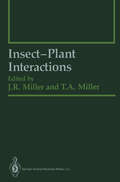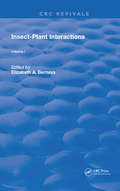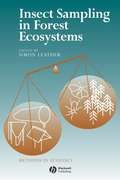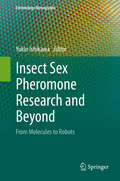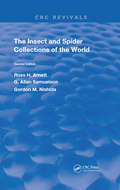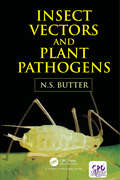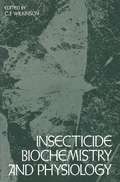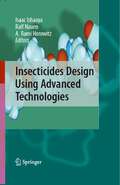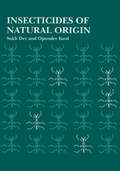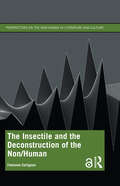- Table View
- List View
Insect Physiology and Biochemistry
by James L. Nation, Sr.Employing the clear, student-friendly style that made previous editions so popular, Insect Physiology and Biochemistry, Fourth Edition presents an engaging and authoritative guide to the latest findings in the dynamic field of insect physiology. The book supplies a comprehensive picture of the current state of the function, development, and reproduction of insects. Expanded and updated, now in full colour, this fourth edition adds three new chapters on the role of the nervous system in behavior; the ‘Genomics Revolution’ in entomology; and global climate changes which have a major effect on insects, including warming and weather. It continues to challenge conventional entomological wisdom with the latest research and analytical interpretations. The text will appeal to upper undergraduate and graduate students and to practicing biologists who need to possess a firm knowledge of the broad principles of insect physiology. With detailed full colour illustrations to help explain physiological concepts and important anatomical details, it remains the most easily accessible guide to key concepts in the field.
Insect-Plant Interactions (Springer Series in Experimental Entomology)
by M. Berenbaum S. Finch J. L. Frazier F. J. Hanke F. E. Hanson I. Ishaaya M. Kogan I. Kubo A. C. Lewis S. B. Opp R. J. Prokopy M. C. Singer W. M. Tingey H.F. van EmdenThe authoritative overviews in this volume provide a wealth of practical information on current approaches to the study of insect-plant interactions. Methods described include direct behavioral observation; assays of host finding, oviposition, and feeding behavior of insect herbivores; post-ingestion physiological effects; measurement of food quality and sensory responses of insects to plant stimuli; chemical isolation and identification of active phytochemicals; evaluation of plant resistance to insects; and the biochemistry of allelochemic interactions.
Insect-Plant Interactions (Routledge Revivals #1)
by Elizabeth A. BernaysFirst Published in 1989, this book explores the relationship between plants and insects and the ways in which they interact with each other. Carefully compiled and filled with a vast repertoire of notes, diagrams, and references this book serves as a useful reference for students of oncology, and other practitioners in their respective fields.
Insect-Plant Interactions (Routledge Revivals #1)
by Elizabeth A. BernaysFirst Published in 1989, this book explores the relationship between plants and insects and the ways in which they interact with each other. Carefully compiled and filled with a vast repertoire of notes, diagrams, and references this book serves as a useful reference for students of oncology, and other practitioners in their respective fields.
Insect Populations In theory and in practice: 19th Symposium of the Royal Entomological Society 10–11 September 1997 at the University of Newcastle
by Jack P. Dempster Ian F. G. McLeanInsects are by far the largest group of animals on Earth, with over a million described species, and they occupy a wide range of ecological niches - they may be herbivores, predators, parasites or decomposers. Some are of particular economic importance as pests of agriculture and forestry, as vectors of animal and human disease, or as species of interest to wildlife conservation. Thus an understanding of the processes determining their numbers is of considerable practical value. Entomologists have played a leading role in developing a theoretical basis to Population Ecology, but we still do not have adequate experimental and observational proof for many of the theoretical ideas that have been proposed. As a result, the subject has been beset with arguments for more than 50 years. This volume attempts to reconcile some of these controversies, while also reviewing the current state of our knowledge. The editors have drawn together an international list of contributors whose views reflect a range of opinions on how natural populations are stabilised. They have succeeded in producing a book that both covers the main alternative views in population theory and contains some of the best recent field studies of insect populations. This Royal Entomological Society Symposium volume will be of great interest to all entomologists and ecologists, particularly those who wish to know more about Population Dynamics.
Insect Predators in Pest Management
by OmkarPests cause damage to the economic value of crops and stored products, while vectors are responsible for the transmission of disease-causing agents in human beings and livestock. Although application of synthetic pesticides in agriculture gives immediate relief, it also causes well-known side effects, leading to a consensus among entomologists and agriculturists to shift towards other ecofriendly pest management methods. Natural enemies of insects including their predators, parasitoids and pathogens have attracted the attention of scientists across the globe. These natural enemies exist in agroecosystems and suppress the populations of pests. Parasitoids are farmers’ friends and the most successful group of natural enemies. Highly specialized/generalized in their prey choice, active stages of predators search for a suitable prey, attack or kill the prey and consume prey within a short handling time. Predatory ability is known to increase with increase in prey density. A single predator may devour several prey individuals. Exploiting this potency of parasitoids may yield successful results in controlling notorious pests in an ecofriendly way. This book provides information on the important biocontrol agents that are effective in pest suppression. It starts with insect parasitic groups followed by specific group of parasitoids. It is hoped that the book presents a comprehensive account of beneficial parasitoids and will be useful to undergraduate and postgraduate students of Entomology, Biological Control, Plant Protection, Agricultural Zoology and Zoology, besides those involved in competitive examinations and policy planning. Features Each chapter has been authored by specialized senior professionals. Every chapter contains Learning Objectives and Points to Remember. This book offers comprehensive knowledge of parasitoids and their application in pest management in a lucid way.
Insect Predators in Pest Management
by OmkarPests cause damage to the economic value of crops and stored products, while vectors are responsible for the transmission of disease-causing agents in human beings and livestock. Although application of synthetic pesticides in agriculture gives immediate relief, it also causes well-known side effects, leading to a consensus among entomologists and agriculturists to shift towards other ecofriendly pest management methods. Natural enemies of insects including their predators, parasitoids and pathogens have attracted the attention of scientists across the globe. These natural enemies exist in agroecosystems and suppress the populations of pests. Parasitoids are farmers’ friends and the most successful group of natural enemies. Highly specialized/generalized in their prey choice, active stages of predators search for a suitable prey, attack or kill the prey and consume prey within a short handling time. Predatory ability is known to increase with increase in prey density. A single predator may devour several prey individuals. Exploiting this potency of parasitoids may yield successful results in controlling notorious pests in an ecofriendly way. This book provides information on the important biocontrol agents that are effective in pest suppression. It starts with insect parasitic groups followed by specific group of parasitoids. It is hoped that the book presents a comprehensive account of beneficial parasitoids and will be useful to undergraduate and postgraduate students of Entomology, Biological Control, Plant Protection, Agricultural Zoology and Zoology, besides those involved in competitive examinations and policy planning. Features Each chapter has been authored by specialized senior professionals. Every chapter contains Learning Objectives and Points to Remember. This book offers comprehensive knowledge of parasitoids and their application in pest management in a lucid way.
Insect Repellents Handbook
by Mustapha Debboun Stephen P. Frances Daniel StrickmanThe public has a great desire for products that prevent the annoyance of biting insects and ticks, but that desire does not always translate into sensible use of those products. Insect Repellents Handbook, Second Edition summarizes evidence-based information on insect repellents to inform decisions by those involved with insect repellent research,
Insect Sampling in Forest Ecosystems
by Simon R. LeatherInsect Sampling in Forest Ecosystems highlights the problems faced by entomologists working in forest ecosystems. Insects play a major part in all aspects of ecology Brings together the methodology needed to investigate insects through the various strata of the forest canopy Covers techniques associated with various specialised groups of forest insects Each chapter is backed up by a sound approach to experimental design and data analysis Essential reading for advanced students and researchers as well as teachers
Insect Sex Pheromone Research and Beyond: From Molecules to Robots (Entomology Monographs)
by Yukio IshikawaThis book provides a complete overview of cutting-edge research on insect sex pheromones and pheromone communication systems. The coverage ranges from the chemistry, biosynthesis, and reception of sex pheromones to the control of odor-source searching behavior, and from molecules to the application of research findings to robotics. The book both summarizes the progress of studies conducted using Bombyx mori and several groups of moths and reviews sex pheromones of some non-lepidopteran insect groups of agricultural importance. Attention is drawn to recent findings on elaborate neural information processing in the brain in male moths and to the importance of olfactory receptors specifically tuned to sex pheromone molecules. Featuring contributions from leading experts on the topic, this book will be a unique and valuable resource for researchers and students in the fields of entomology, chemical ecology, insect physiology and biochemistry, evolution, biomimetics, and bioengineering. In addition to researchers, general insect lovers will find the book fascinating for its descriptions of the marvelous abilities of insects and the underlying mechanisms involved.
The Insect & Spider Collections of the World (CRC Press Revivals)
by Ross H. Arnett, Jr. G. Allan Samuelson Gordon M. NishidaFirst published in 1993, completely rewritten, this second edition includes a list of all 210 countries of the world and all of the islands, with comments on the existence of insect and spider collections, both public and private. These listings are arranged alphabetically by country, state/province, and city, with private collections listed under the public collection with which they are registered. Part II of the directory is an alphabetical list of the codes assigned to each of the collections described in Part I. This list is also cross-referenced to variations of the codes used in other works, which will eliminate any confusion over this duplication. This classic work provides a ready reference to all collections and is required by all insect and spider systematists.
The Insect & Spider Collections of the World (CRC Press Revivals)
by Ross H. Arnett, Jr. G. Allan Samuelson Gordon M. NishidaFirst published in 1993, completely rewritten, this second edition includes a list of all 210 countries of the world and all of the islands, with comments on the existence of insect and spider collections, both public and private. These listings are arranged alphabetically by country, state/province, and city, with private collections listed under the public collection with which they are registered. Part II of the directory is an alphabetical list of the codes assigned to each of the collections described in Part I. This list is also cross-referenced to variations of the codes used in other works, which will eliminate any confusion over this duplication. This classic work provides a ready reference to all collections and is required by all insect and spider systematists.
Insect Timing: Circadian Rhythmicity to Seasonality
by D. L. Denlinger J. Giebultowicz D. S. SaundersLeading experts in the field bring together diverse aspects of insect timing mechanisms. This work combines three topics that are central to the understanding of biological timing in insects: circadian rhythms, photoperiodism, and diapause. The common theme underlining each of the contributions to this book is an understanding of the timing of events in the insect life cycle. Most daily activities (emergence, feeding, mating, egg laying, etc.) undertaken by insects occur at precise times each day. Likewise, seasonal events such as the entry into or termination from an overwintering dormancy (diapause) occur at distinct times of the year. This book documents such events and provides an up-to-date interpretation of the molecular and physiological events undergirding these activities.The study of circadian rhythms has undergone a flowering in recent years with the molecular dissection of the components of the circadian clock. Now that many of the clock genes have been identified it is possible to track daily patterns of clock-related mRNAs and proteins to link the entraining light cycles with molecular oscillations within the cell. Insect experiments have led the way in demonstrating that the concept of a "master clock" can no longer be used to explain the temporal organization within an animal. Insects have a multitude of cellular clocks that can function independently and retain their function under organ culture conditions, and they thus offer a premier system for studying how the hierarchical organization of clocks results in the overall temporal organization of the animal. Photoperiodism, and its most obvious manifestation, diapause, does not yet have the molecular underpinning that has been established for circadian rhythms, but recent studies are beginning to identify genes that appear to be involved in the regulation of diapause. Overall, the book presents the rich diversity of challenges and opportunities provided by insects for the study of timing mechanisms.
Insect Ultrastructure: Volume 1
by H. Akai R. C. KingFourteen years have passed since the publication of David Spencer Smith's Insect Cells: Their Structure and Function. Here the results of a decade of electronmicroscopic studies on insect cells were summarized in an organized and integrated fashion for the first time, and the ultrastructural characteristics of different specialized cells and tissues were abundantly illustrated in the 117 plates this monograph contained. In the intervening period great progress has been made in the field of Insect Ultrastructure. Organelles not even mentioned in Smith's book, such as synaptonemal complexes, clathrin baskets, fusomes, and retinular junc tions, have been identified and functions proposed for them. There have also been many technical advances that have profoundly influenced the direction of subsequent research. A spectacular example would be the development by Miller and Beatty of the chromosomal spreading technique which allowed for the first time ultrastructural studies on segments of chromosomes containing genes in various stages of replication and transcription. Then there is the freeze-fracture procedure first described by Moor and his colleagues. This technique permitted an analysis of intercellular junctions that was impossible with the conventional sectioning methods. The results greatly clarified our understanding of the channels for ion movement and the permeability barriers between cells and also the membrane changes that occur during the embryonic differentiation and metamorphosis of various types of insect cells.
Insect Ultrastructure: Volume 2
by H. Akai R. C. KingCell biology is moving at breakneck speed, and many of the results from studies on insects have helped in understanding some of the central problems of biology. The time is therefore ripe to provide the scientific community with a series of up-to-date, well illustrated reviews of selected aspects of the sub microscopic cytology of insects. The topics we have included fall into four general groups: seven chapters deal with gametogenesis, four concern develop ing somatic cells, seventeen chapters describe specialized tissues and organs, and three chapters cover cells in pathological states. These accounts are illustrated with over 600 electron micrographs. The more than 1100 pages in the two volumes of Insect Ultrastructure combined labors of 49 dedicated contributors from II countries. represent the These authors have digested and critically summarized a very large body of information, and some measure of this effort can be gained from consulting the bibliographies that close each of the 31 chapters. These contain 2400 publica tions authored by 1500 different scientists. However, before we congratulate ourselves on the advanced state of our knowledge, it is worth remembering that representatives of less than 0.01 % of the known species of insects have been examined with the electron microscope.
Insect Vectors and Plant Pathogens
by Nachhattar Singh ButterThe history of pathogens and vectors, unique symptoms of diseases and economic importance of important viral diseases have been dealt with in the introductory chapter of this book. While highlighting the role of arthropods, nematodes, and fungi; other agents of the spread of plant pathogens have also been included. Important aspects of insect vectors with direct bearing on transmission, i.e. vector identification, biology, feeding apparatus, and mechanism of spread including control of pathogens through vectors are covered comprehensively. As aphids and other hemipterous insects are major insect vectors, the book stresses on this order. There is a focus on the transmission of determinants under different categories of the transmission mechanism. The transmission determinant paradigm comprising coat protein and helper component has been expounded with recent cases. A brief description of new diseases at least one from each genus of plant viruses has been included in this compendium to elucidate the interaction of vector and virus. Phytoplasmal etiology of pathogens has been detailed separately on account of their importance. The transmission of plant viruses through insects with biting and chewing type of mouth parts has been discussed in detail as separate chapter. The latest research in the field of mites, nematodes, and fungi as vectors of plant viruses has been included. How the phytotoxemia is different from other crop disorders, has been critically explained with support from suitable and common examples of crop disorders. The book also highlights the effects of plant viruses on their vectors. An account of classification of plant viruses has also been given for better understanding of subject matter. Likewise, the information on the electron microscope along with its use has been included so as to define the procedure of examining sub-microscopic entities. The latest developments in the management of plant pathogens through vector management have been discussed with special reference to the use of biotechnology, crop protection, and plant resistance. The book will be of value to the teachers and to researchers. It will also be useful for extension workers in managing crop disorders. Students and researchers of entomology, plant pathology, plant protection and virology disciplines will obtain the latest in the field, through this book.
Insect Vectors and Plant Pathogens
by Nachhattar Singh ButterThe history of pathogens and vectors, unique symptoms of diseases and economic importance of important viral diseases have been dealt with in the introductory chapter of this book. While highlighting the role of arthropods, nematodes, and fungi; other agents of the spread of plant pathogens have also been included. Important aspects of insect vectors with direct bearing on transmission, i.e. vector identification, biology, feeding apparatus, and mechanism of spread including control of pathogens through vectors are covered comprehensively. As aphids and other hemipterous insects are major insect vectors, the book stresses on this order. There is a focus on the transmission of determinants under different categories of the transmission mechanism. The transmission determinant paradigm comprising coat protein and helper component has been expounded with recent cases. A brief description of new diseases at least one from each genus of plant viruses has been included in this compendium to elucidate the interaction of vector and virus. Phytoplasmal etiology of pathogens has been detailed separately on account of their importance. The transmission of plant viruses through insects with biting and chewing type of mouth parts has been discussed in detail as separate chapter. The latest research in the field of mites, nematodes, and fungi as vectors of plant viruses has been included. How the phytotoxemia is different from other crop disorders, has been critically explained with support from suitable and common examples of crop disorders. The book also highlights the effects of plant viruses on their vectors. An account of classification of plant viruses has also been given for better understanding of subject matter. Likewise, the information on the electron microscope along with its use has been included so as to define the procedure of examining sub-microscopic entities. The latest developments in the management of plant pathogens through vector management have been discussed with special reference to the use of biotechnology, crop protection, and plant resistance. The book will be of value to the teachers and to researchers. It will also be useful for extension workers in managing crop disorders. Students and researchers of entomology, plant pathology, plant protection and virology disciplines will obtain the latest in the field, through this book.
The Insect Viruses (The Viruses)
by Lois K. Miller L. Andrew BallThere are over a million different species of insects, and individually they 8 outnumber humans by more than 10 to 1. Moreover, some insects live in close association with both plants and higher animals and naturally exchange viruses with them. It has even been speculated that viruses in general may have radiated through the plant and animal kingdoms from common insect origins. Be that as it may, since insects play pivotal roles in the biosphere, both to the benefit and detriment of mankind, they and the viruses that infect them are important subjects for study. Insects are infected by a diverse medley of viruses, and this volume focuses on those insect virus families that are found primarily or exclusively in insects. All major families of insect-selective viruses are covered except for the baculo viruses, which were described in a separate volume of The Viruses series. Included in this volume are the established families of insect viruses, the newly recognized ascovirus family, and the nudiviruses, which probably represent a separate family but currently remain unclassified. The coverage of arboviruses is limited to a single chapter that focuses on their potential utility as vectors and in insect control. Omitted for practical reasons are several individual insect viruses that have been described sporadically in the literature and probably represent novel virus families.
Insecta: Süßwasserfauna von Mitteleuropa. Bd. 20/17 (Süßwasserfauna von Mitteleuropa)
by Bernhard KlausnitzerDer vorliegende Band der Reihe „Süßwasserfauna von Mitteleuropa" umfasst in seinem Inhalt erstmals die gesamte Westpaläarktis (Europa, Nordafrika, Vorderasien). Er enthält zusammenfassende Angaben über die Morphologie, Biologie, Ökologie und Verbreitung der Scirtidae (Sumpfkäfer). Zusätzlich zur Charakterisierung der Familie werden die einzelnen Gattungen, Artengruppen (nicht bei allen Gattungen vorhanden) und Arten ausführlich dargestellt. Reich illustrierte Bestimmungstabellen führen zu den einzelnen Taxa. Viele Merkmale sind abgebildet und gemessen (über 1000 Einzelabbildungen, meist Fotos von Mikropräparaten, einige REM-Bilder, 8 Farbtafeln). Das führt dann zu einer sicheren Determination, wodurch ökologische und tiergeografische Aussagen ermöglicht werden. Für Limnologen, aber auch Entomologen, Biogeografen und Zoologen, die sich mit der Süßwasserfauna befassen, ist dieses Werk unverzichtbar.
Insecticide Action: From Molecule to Organism
by J. E. Chambers T. NarahashiIntoxication of humans and animals has become increasingly important in recent years as has contamination of the environment by a variety of chemicals. In order to develop effective means by which such intoxication and contamination can be properly handled, it is imperative to know how these environmental agents act in humans and animals. Despite studies conducted by various investigators, the mechanisms of action of these environmental agents have not been fully elucidated. Insecticides are by no means an exception in terms of the seriousness of the problem and of the urgency of the need for such information. In order to complete a picture of the effects of any particular insecticide, it is of utmost importance that its actions at various levels ranging from those of molecules to whole animals be analyzed and synthesized. To understand the toxicological action on animals or humans, it is not sufficient to know the action at each level only. The actions at various levels must be integrated to construct a picture of the toxic effect on the intact organism. However, in spite of the large body of information that has been accumulated during the past few decades, little or no attempt has been made to integrate experimental data obtained at the molecular, cellular, organ, and animal levels together in order to define the whole picture of insecticidal action.
Insecticide Biochemistry and Physiology
by WilkinsonOnly four short decades ago, the control of insect pests by means of chemicals was in its early infancy. The pioneers in the area consisted largely of a group of dedicated applied entomologists working to the best of their abilities with a very limited arsenal of chemicals that included inorganics (arsenicals, fluorides, etc.), some botanicals (nicotine), and a few synthetic organics (dinitro-o-cresol, organothiocyanates). Much of the early research was devoted to solving practical problems associated with the formulation and application of the few existing materials, and although the discovery of new types of insecticidal chemicals was undoubtedly a pipe dream in the minds of some, little or no basic research effort was expended in this direction. The discovery of the insecticidal properties of DDT by Paul Miiller in 1939 has to be viewed as the event which marked the birth of modern insecticide chemistry and which has served as the cornerstone for its subse quent developement. DDT clearly demonstrated for the first time the dramatic potential of synthetic organic chemicals for insect control and provided the initial stimulus which has caused insecticide chemistry to become a field not only of immense agricultural and public health importance but also one that has had remarkable and unforseeable repercussions in broad areas of the physical, biological, and social sciences. Indeed, there can be few other synthetic chemicals which will be judged in history to have had such a broad and telling impact on mankind as has DDT.
Insecticides Design Using Advanced Technologies
by Isaac Ishaaya Ralf Nauen A. Rami HorowitzAmong the highlights of this book are the use of nanotechnology to increase potency of available insecticides, the use of genetic engineering techniques for controlling insect pests, the development of novel insecticides that bind to unique biochemical receptors, the exploration of natural products as a source for environmentally acceptable insecticides, and the use of insect genomics and cell lines for determining biological and biochemical modes of action of new insecticides.
Insecticides of Natural Origin
by Sukh DevNature has often provided valuable molecules either as lead compounds or for use in the fight against pests. Though a number of conference proceedings deal with the control of insects using natural products, there is no comprehensive account of what materials have been studied and what results have been obtained. Examining the material scattered across various disciplines, this book meets a recognized need by consolidating this information in one volume. The first section of the book covers chemistry and biological activity of major classes of naturally occurring pesticides, including the development of more potent insecticides based on natural lead-in structures. The second section consists of monographs on each compound by product.
Insecticides of Natural Origin
by Sukh DevNature has often provided valuable molecules either as lead compounds or for use in the fight against pests. Though a number of conference proceedings deal with the control of insects using natural products, there is no comprehensive account of what materials have been studied and what results have been obtained. Examining the material scattered across various disciplines, this book meets a recognized need by consolidating this information in one volume. The first section of the book covers chemistry and biological activity of major classes of naturally occurring pesticides, including the development of more potent insecticides based on natural lead-in structures. The second section consists of monographs on each compound by product.
The Insectile and the Deconstruction of the Non/Human (Perspectives on the Non-Human in Literature and Culture)
by Fabienne CollignonThe Insectile and the Deconstruction of the Non/Human defines, conceptualizes, and evaluates the insectile—pertaining to an entomological fascination—in relation to subject formation. The book is driven by a central dynamic between form and formlessness, further staging an investigation of the phenomenon of fascination using Lacanian psychoanalysis, suggesting that the psychodrama of subject formation plays itself out entomologically. The book’s engagement with the insectile—its enactments, cultural dreamwork, fantasy transformations—‘in-forming’ the so-called human subject undertakes a broader deconstruction of said subject and demonstrates the foundational but occluded role of the insectile in subject formation. It tracks the insectile across the archives of psychoanalysis, seventeenth century still life painting, novels from the nineteenth century to the present day, and post-1970s film. The Insectile and the Deconstruction of the Non/Human will be of interest for scholars, graduate students, and upper-level undergraduates in film studies, visual culture, popular culture, cultural and literary studies, comparative literature, and critical theory, offering the insectile as new category for theoretical thought.

